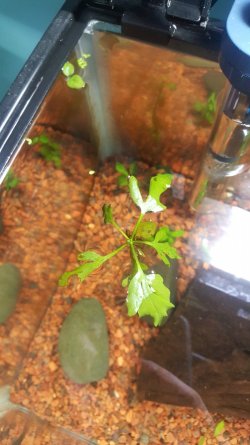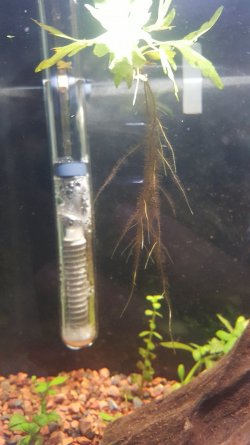You are using an out of date browser. It may not display this or other websites correctly.
You should upgrade or use an alternative browser.
You should upgrade or use an alternative browser.
mysterious floating plant
- Thread starter Meg0000
- Start date
-
- Tags
- floating plant
I agree. It’s water Sprite.
Agree. It is Ceratopteris cornuta judging by the leaf structure, and this is the best species for floating. It is also without question the best floating plant in an aquarium. You may find my profile of this species published on another site helpful:
Ceratopteris cornuta
Family: Ceratopteridaceae
Common Names: Water Sprite, Indian Fern
Origin: Tropical regions of Africa, Americas, Asia and northern Australia. The ICUN geographic distribution is given as tropical Africa, Iraq to south east and east Asia, and northern Australia. Mainly confined to shallow waters, particularly swamps, pools and ponds.
Ideal position in aquarium: Best used as a floating plant, but can be grown rooted in the substrate.
Lighting requirements: When left floating will grow well under any light that is not too bright; submersed plants grown in the substrate require moderate to high light.
Growth rate: Moderate to rapid.
Minimum Tank Suggestion: Suitable for any aquarium. It is easy to keep under control by removing the daughter plants periodically and discarding the larger parent plant.
Water parameters: Soft to moderately hard (hardness up to 18 dGH), acidic to basic (pH 5.4 to 8) water, temperature 18-28C/64-82F. Does not like sudden significant changes in water parameters.
Discussion:
This is probably the easiest aquarium plant to grow, at least when left floating, and because of its rapid growth it quickly assimilates nutrients including ammonia/ammonium and is therefore quite useful in new tanks. It assimilates nutrients primarily through the leaves rather than the roots.
The leaves, or more correctly fronds, since this is a true fern, can be somewhat variable in shape due to light, nutrients and water parameters. This makes identification of this species difficult, and it is often encountered in the literature under the names Ceratopteris pteridioides and C. thalictroides, although both these are now accepted distinct species. C. pteridioides has blunt-lobed fronds (leaves), while C. thalictroides has fronds that are deeply pinate with tips more slender than the subject species. There is some uncertainty over the taxonomy and distribution of Ceratopteris thalictroides and C. cornuta with some botanists considering these as one single species. There are currently (2018) five recognized distinct species in the genus Ceratopteris.
Daughter plants are readily produced from the sporangia on the older and alternate fronds. When left floating, the fronds may extend up to 50 cm (20 inches) across, and will block light from entering the aquarium; this is particularly useful to provide a darker environment such as for spawning fish. In such conditions, suitable substrate plants are any of the Cryptocoryne species, Java Moss, etc. depending upon the amount of light getting through. Otherwise, the daughter plants can be separated and used as individual plants and the parent plant discarded in order to keep the water surface more open.
The dangling roots of floating Ceratopteris provide admirable shelter for fry, and are used by the anabantids that build bubblenests. Many fish including anabantids, characins, etc., will regularly browse the roots for particles of food.
Formerly there were five species recognized [some authorities only recognized four] in the genus Ceratopteris that was placed in the monogeneric family Parkeriaceae, thought to be unique because of its aquatic adaptations. Subsequent genetic analysis has shown the Ceratopteris species to be clearly allied with those in the genus Acrostichum, and Ceratopteridaceae is the family name for the clade that is now known to include these two genera. Some authorities place these two genera within the Pteridaceae family.
At the time of writing (revised, 2018) there are five species recognized as accepted by The Plant List: Ceratopteris cornuta, C. pteridoides, C. richardii, C. succulenta, and C. thalictroides. Six other species names are synonymous with one of these, and there are three unresolved species names.
References:
Kasselmann, Christel (2003), Aquarium Plants, Krieger Publishing Company.
The Plant List, online at http://www.theplantlist.org/tpl1.1/search?q=Ceratopteris
Ceratopteris cornuta
Family: Ceratopteridaceae
Common Names: Water Sprite, Indian Fern
Origin: Tropical regions of Africa, Americas, Asia and northern Australia. The ICUN geographic distribution is given as tropical Africa, Iraq to south east and east Asia, and northern Australia. Mainly confined to shallow waters, particularly swamps, pools and ponds.
Ideal position in aquarium: Best used as a floating plant, but can be grown rooted in the substrate.
Lighting requirements: When left floating will grow well under any light that is not too bright; submersed plants grown in the substrate require moderate to high light.
Growth rate: Moderate to rapid.
Minimum Tank Suggestion: Suitable for any aquarium. It is easy to keep under control by removing the daughter plants periodically and discarding the larger parent plant.
Water parameters: Soft to moderately hard (hardness up to 18 dGH), acidic to basic (pH 5.4 to 8) water, temperature 18-28C/64-82F. Does not like sudden significant changes in water parameters.
Discussion:
This is probably the easiest aquarium plant to grow, at least when left floating, and because of its rapid growth it quickly assimilates nutrients including ammonia/ammonium and is therefore quite useful in new tanks. It assimilates nutrients primarily through the leaves rather than the roots.
The leaves, or more correctly fronds, since this is a true fern, can be somewhat variable in shape due to light, nutrients and water parameters. This makes identification of this species difficult, and it is often encountered in the literature under the names Ceratopteris pteridioides and C. thalictroides, although both these are now accepted distinct species. C. pteridioides has blunt-lobed fronds (leaves), while C. thalictroides has fronds that are deeply pinate with tips more slender than the subject species. There is some uncertainty over the taxonomy and distribution of Ceratopteris thalictroides and C. cornuta with some botanists considering these as one single species. There are currently (2018) five recognized distinct species in the genus Ceratopteris.
Daughter plants are readily produced from the sporangia on the older and alternate fronds. When left floating, the fronds may extend up to 50 cm (20 inches) across, and will block light from entering the aquarium; this is particularly useful to provide a darker environment such as for spawning fish. In such conditions, suitable substrate plants are any of the Cryptocoryne species, Java Moss, etc. depending upon the amount of light getting through. Otherwise, the daughter plants can be separated and used as individual plants and the parent plant discarded in order to keep the water surface more open.
The dangling roots of floating Ceratopteris provide admirable shelter for fry, and are used by the anabantids that build bubblenests. Many fish including anabantids, characins, etc., will regularly browse the roots for particles of food.
Formerly there were five species recognized [some authorities only recognized four] in the genus Ceratopteris that was placed in the monogeneric family Parkeriaceae, thought to be unique because of its aquatic adaptations. Subsequent genetic analysis has shown the Ceratopteris species to be clearly allied with those in the genus Acrostichum, and Ceratopteridaceae is the family name for the clade that is now known to include these two genera. Some authorities place these two genera within the Pteridaceae family.
At the time of writing (revised, 2018) there are five species recognized as accepted by The Plant List: Ceratopteris cornuta, C. pteridoides, C. richardii, C. succulenta, and C. thalictroides. Six other species names are synonymous with one of these, and there are three unresolved species names.
References:
Kasselmann, Christel (2003), Aquarium Plants, Krieger Publishing Company.
The Plant List, online at http://www.theplantlist.org/tpl1.1/search?q=Ceratopteris
No problem!Thanks for all the replies!
Similar threads
- Replies
- 3
- Views
- 311
- Replies
- 5
- Views
- 375



